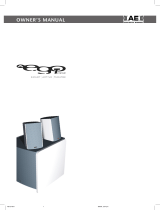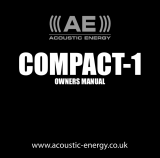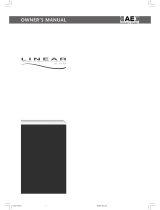Page 1
3. Installation and Positioning
Contents
1. Introduction
2. Handling
Aego-T is a satellite and subwoofer loudspeaker
system designed to be used in domestic audio and
audio-visual (home theatre) systems. It comprises
a compact passive satellite speaker and an active
(powered) subwoofer. The satellite speakers may
be used either placed on furniture or wall-mounted
using the included brackets. The subwoofer should
be used placed on the floor. Use of the satellite
wall-brackets is described in Section 4.
Aego-T satellites need to be connected to an
external power amplifier - this might be a
conventional hi-fi stereo amplifier or a multi-
channel home theatre amplifier/processor. In
either case it should have the facility to provide an
appropriate line-level subwoofer output signal.
Aego-T systems comprising between two and
seven satellites speakers may be installed with
one subwoofer. Systems including more than
seven satellite speakers should include multiple
subwoofers.
To ensure that programme material is heard as
intended it is important that each Aego-T element
is located appropriately. For Aego-T systems
comprising from two to seven satellites locate the
speakers as described in the following paragraphs
and refer to Diagram One over the page. Don’t
worry if it is not practical to follow the diagram
exactly but experiment with the options that
are practical in order to find the one that works
best. Once your Aego-T system is connected
and working (see Section 6), and you begin to
become familiar with its performance, it is likely to
be worthwhile experimenting a little further with
positioning.
Two satellites only (Stereo System)
A stereo system is most likely to be used for
conventional stereo audio only rather than audio-
visual programme. In this case the satellites should
be located near or on the wall facing the listening
position and;
• Between 0.05 and 0.5 metres from the rear
wall.
• 1.0 metres from side walls and clear of corners.
• Between 2.0 and 3.5 metres apart.
• Equidistant from and angled towards the
listening position.
The location of the subwoofer is less critical but it should be placed a similar
distance away from the listening position as the satellites. Try to avoid a
location for the subwoofer exactly halfway along the length or width of the
room.
Three satellites, one subwoofer (3.1 System)
A 3.1 system is most likely to be used for audio-visual (home theatre)
programme. In this case the satellites should be located one either side of the
screen, and one centrally either directly above or below the screen. The basic
positioning guidelines for the left and right satellites are the same as for the
2.1 system described above. The central satellite may be positioned either on
the wall, on a furniture unit or a screen stand.
The location of the subwoofer is less critical but it should be placed a similar
distance away from the listening position as the satellites. Try to avoid a
location for the subwoofer exactly halfway along the length or width of the
room.
Five satellites, one subwoofer (5.1 System)
A 5.1 system is most likely to be used for audio-visual (home theatre)
programme. In this case, three satellites should be located in front of listening
position, one either side of the screen and one centrally, and two “surround”
satellites located just behind the listening position one either side of the room.
The front central satellite should be located either directly above or below the
screen. The surround satellites may be located well above head height. The
basic positioning guidelines for the left and right satellites are the same as for
the 2.1 system described earlier. The central satellite may be positioned either
on the wall, on a furniture unit or a screen stand.
The location of the subwoofer is less critical but it should be placed a similar
distance away from the listening position as the satellites. Try to avoid a
location for the subwoofer exactly halfway along the length or width of the
room.
Seven satellites, one subwoofer (7.1 System)
A 7.1 system is most likely to be used for audio-visual (home theatre)
programme. In this case, three satellites should be located in front of listening
position, one either side of the screen and one centrally, two “surround”
satellites just behind the listening position one either side of the room, and a
two further surround satellites directly behind the listening position. The front
central satellite should be located either directly above or below the screen.
The surround satellites may be located well above head height. The basic
positioning guidelines for the left and right satellites are the same as for the
2.1 system described earlier. The central satellite may be positioned either on
the wall, on a furniture unit or a screen stand.
The location of the subwoofer is less critical but it should be placed a similar
distance away from the listening position as the satellites. Try to avoid a
location for the subwoofer exactly halfway along the length or width of the
room.



















